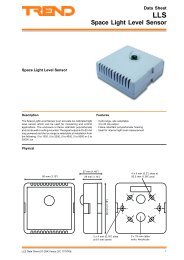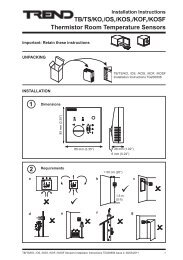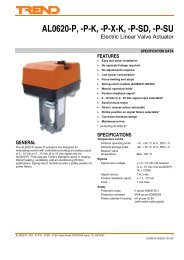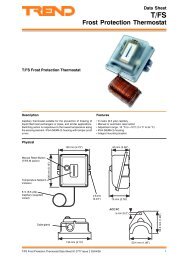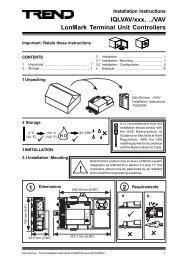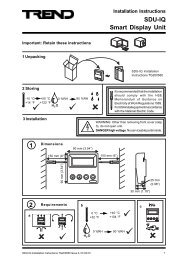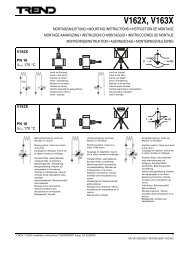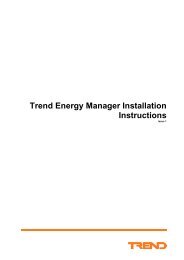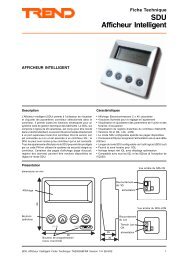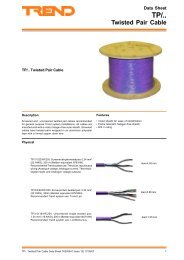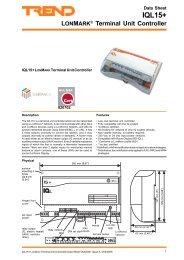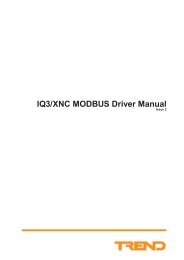Specification sheet (English) - Trend
Specification sheet (English) - Trend
Specification sheet (English) - Trend
Create successful ePaper yourself
Turn your PDF publications into a flip-book with our unique Google optimized e-Paper software.
) ,, 4- 5 5 * ) 7,<br />
"<br />
&<br />
$<br />
!<br />
$ "<br />
'<br />
' $<br />
<br />
<br />
<br />
Data Sheet<br />
IQ23x<br />
Series Controllers<br />
IQ23x Series Controller<br />
Description<br />
The IQ231 and IQ233 mid range controllers are specifically<br />
designed for field replacement of the older IQ111 (111+) and<br />
IQ131 (131+) controllers respectively. They are also useful in<br />
new installations, for a broad range of applications. The IQ231<br />
has 16 input/output points, and the IQ233 has 32 points. Options<br />
are available for an integral or external 2-line display panel.<br />
Features<br />
▪▪<br />
Good hardware and software compatibility for field<br />
replacement of IQ111 (+) and IQ131 (+) controllers.<br />
▪▪<br />
20 universal inputs maximum (IQ231 has 8).<br />
▪▪<br />
12 analogue voltage outputs maximum (IQ231 has 8).<br />
▪▪<br />
Integral or external 2-line display options.<br />
▪▪<br />
Local supervisor connection.<br />
▪▪<br />
1 second cycle time and extended logging.<br />
Physical<br />
AC input power<br />
external 2-line<br />
display panel option<br />
RS232/modem<br />
(for auxiliary node)<br />
auxiliary node knockout<br />
fail LED<br />
power LED<br />
! 8<br />
4 ,5<br />
4 5 ! <br />
, -<br />
) 7:<br />
"8<br />
local supervisor port<br />
4 4 <br />
address/baud<br />
rate switch<br />
6 6 4 4 4 N<br />
<br />
6 N<br />
6 6 <br />
4 :<br />
<strong>Trend</strong> Lan connectors<br />
earth stud (M3)<br />
<strong>Trend</strong> Lan LEDs<br />
6 :<br />
24 Vdc auxiliary output<br />
supply<br />
, 2<br />
integral 2-line<br />
display panel<br />
option<br />
)<br />
*<br />
+<br />
,<br />
288 mm (11.34”)<br />
earth flange<br />
cable cleats<br />
inputs<br />
339 mm (13.35”)<br />
analogue outputs<br />
93 mm (3.66”)<br />
IQ23x Series Controllers Data Sheet TA200538 Issue 2, 18-Jan-20121
IQ23x<br />
Data Sheet<br />
Functionality<br />
The IQ Controller’s functionality can be divided into three sections, strategy, firmware, and hardware.<br />
Strategy<br />
The strategy processes inputs according to a set of instructions<br />
and then outputs signals which can be used to control plant.<br />
Configuration: The IQ23x uses the standard IQ configuration<br />
mode which enables configuration by way of the network, or<br />
the supervisor port. SET can be used to create a strategy data<br />
file (.IQ2) which can then be downloaded to the controller and<br />
subsequently uploaded for backup purposes if connected to the<br />
controller directly, by way of the network or by way of a modem.<br />
A strategy data file from an IQ1xx controller (.IQF) can be<br />
downloaded to an IQ23x and will require modification as<br />
explained in the compatibility section<br />
Modules: The strategy consists of a number of individual<br />
functional blocks known as configuration modules. These<br />
blocks can be linked in various combinations to enable plant to<br />
be controlled in accordance with the building’s requirements.<br />
The table lists the different types of configuration modules and<br />
the number of each type available with IQ23x.<br />
Module Type Number Module Type Number<br />
Sensor 48 Critical Alarm 4<br />
Sensor type 15 Alarm History 20<br />
Loop 32 IC Comms 16<br />
Function 160 Digital Inputs 48<br />
Logic 160 Fast Sequence 8<br />
Driver 32 Zone 5<br />
Knob 30 Schedule 32<br />
Switch 20 Calendar 20<br />
Sensor log 32 User Password 6<br />
Sequence step 400 Sequence time 1 s<br />
Analogue Nodes 255 Digital Nodes 506<br />
Display 200 Directory 40<br />
Page 50 Group 10<br />
Route 50 Destination 7<br />
New Alarm Log 200<br />
Full details of the modules are given in the IQ Configuration<br />
Manual and Addendum. The IQ23x contains the normal IQ2<br />
features as described in IQ Configuration Manual Addendum:<br />
Engineers Journal (J), I/O Summary (i/o) Loader Issue (R(c),’c’<br />
lower case), Serial Number (R(s), ‘s’ lower case), Supply<br />
Frequency Option, Enhanced Logging, Module position, and<br />
Strategy Cleardown. Differences between the modules covered<br />
in the manuals and the IQ23x’s modules are covered below.<br />
Address Module<br />
It has two additional items described below:<br />
default PIN disable: This increases the controller security by<br />
disabling the default PIN. It is accessed using the character<br />
“d”, setting d=1 will disable the default PIN. It may be enabled<br />
by setting d=0 (as long as a valid PIN is used). This change<br />
requires a PIN with level 99. If the default PIN is disabled and<br />
the PIN settings are unknown (e.g PINs forgotten or after<br />
battery replacement), the unit can be restored by clearing the<br />
strategy using the address/baud rate switch zero reset and then<br />
downloading the strategy.<br />
Firmware<br />
Communications: When operating as part of a Building<br />
Management System, the IQ23x will be connected to other<br />
devices by way of the <strong>Trend</strong> Network. This means that<br />
information within the IQ23x can be accessed using one of<br />
the <strong>Trend</strong> supervisor programs, or passed to other <strong>Trend</strong> IQ<br />
controllers using inter‐controller communications, enabling the<br />
sharing of information across the whole system.<br />
When connected to the network the controller can use up to<br />
2 different addresses. One address is for the controller itself,<br />
the second is optional, and is for the supervisor port (locally<br />
connected supervisor). The controller’s address is set by a<br />
switch, and the supervisor port address is set up in the strategy<br />
configuration (address module).<br />
Hardware<br />
Unit: The IQ23x is supplied in a metal enclosure. It has 4<br />
mounting points which are on the same centres as the IQ111+<br />
and IQ131+; they are also the same as those provided by the<br />
IQ111 or IQ131 using the mounting bars. Its footprint is smaller<br />
than IQ111 or IQ131, and the same as the IQ111 or IQ131 with<br />
their mounting bars, but it is 13 mm deeper<br />
Connectors: Two part connectors are used throughout<br />
to facilitate wiring. An earth flange is provided for screen<br />
termination with a special M3 earth stud close to the network<br />
connection, and there are cleats for cable restraint.<br />
Power: 230 Vac 50/60 Hz.<br />
Note that this unit must be earthed (grounded) via the Earth<br />
terminal of the IEC connector.<br />
Fusing: The controller has no replaceable fuses; protection<br />
is provided by means of a self-resetting thermally protected<br />
transformer.<br />
Indicators: LED indicators for receive and transmit network<br />
current flow (RX, TX) and network OK ( ), also for all I/O<br />
channels, power ( ), and fail ( ). See specification section for<br />
details.<br />
Network: The network terminals facilitate connection of 4 wire<br />
cables. The standard <strong>Trend</strong> node features are included (TX,<br />
RX, and network OK, , indicators, bypass relay, and network<br />
alarm generation). There is also the facility for connection of a<br />
supervisor or network display panel to the network by way of<br />
the controller without the need for an additional node controller.<br />
Internal Node: A node controller card may be fitted inside<br />
the unit either as a pre-fitted option, or post-fitted using the<br />
appropriate cables. There is a two pin polarised plug to supply<br />
24 Vdc to the node and a four pin polarised plug which provides<br />
a network connection. There is a set of two pairs of pins<br />
adjacent to the network plug which are normally shorted by two<br />
links; these must be removed when the node is connected. For<br />
an integral node controller to operate the external network must<br />
be connected, or the external network terminals must be linked<br />
(TX to RX).<br />
sUperv port addr: This operates as described in the IQ<br />
Configuration manual addendum with the additional feature that<br />
if the address is set to 120, the supervisor port will be disabled.<br />
This gives increased security. The port can be enabled by<br />
setting the address to another value by configuration or text<br />
comms over the network.<br />
Byte 506, Bit 1<br />
This bit now has the fixed function of ‘IQ1 series simulation of<br />
universal input action’ (see Compatibility section, Firmware).<br />
2 IQ23x Series Controllers Data Sheet TA200538 Issue 2, 18-Jan-2012
Data Sheet<br />
IQ23x<br />
Hardware (continued)<br />
A node is post-fitted using KIT/NODE/IQ23x. This provides<br />
mounting plates, pillars, screws, and cables to enable<br />
connection of the current nodes (TMN, CNC2, PNC2, INC2,<br />
LINC, and XN28); the node card is ordered separately. There<br />
is a 25 way D type knockout on the upper panel for RS232<br />
connection to the node, and a circular knockout for 14.25 mm<br />
grommet for internetwork, PSTN, ISDN, or Lon cables.<br />
The two links on each input channel must be correctly positioned<br />
to set up the type of input required.<br />
6<br />
loop powered<br />
, 8<br />
loop powered<br />
1<br />
View on top of<br />
board<br />
mounting plate network<br />
connector<br />
J2<br />
J47<br />
J48<br />
supply<br />
connector<br />
network links<br />
R+T+T-R-<br />
externally powered<br />
, N 1N<br />
externally powered<br />
Address/Baud rate switch: The address on the Lan is set by<br />
poles 1 to 7 in range 1, 4 to 9, 11 to 119 and must be unique on<br />
the Lan. The baud rate is set by poles 8 to 10 in the range 1k2,<br />
4k8, 9k6, 19k2 and must match the other nodes on the Lan.<br />
The 4k8 baud rate is selected by setting all three poles to zero.<br />
The address/baud rate switch may also be used to perform a<br />
strategy cleardown; this is done by setting all the address/baud<br />
rate poles to zero before power up (see Installation Instructions,<br />
TG200539 <strong>sheet</strong> 3 and IQ Configuration Manual Addendum).<br />
For this reason the address should normally be set non-zero.<br />
Analogue Voltage Outputs 8<br />
(IQ231: channels 1 to 8; IQ233: channels 1 to 12)<br />
Link Headers<br />
A range of link headers is available to enable the input channels<br />
to accept a wider range of inputs:<br />
LKE/5V: Provides 5V, 20 mA supply<br />
13 ! N<br />
Battery Backup: Details about the strategy configuration, time<br />
and date, and logged data are stored in RAM. A plug‐in lithium<br />
cell provides power to maintain the data in the event of power<br />
failure, or the controller being switched off.<br />
<br />
& <br />
24 Vdc Auxiliary Supply: The IQ23x has a 24 Vdc auxiliary<br />
500 mA supply protected by a self-resetting passive thermal<br />
device. It is available from two terminals on the back of the unit<br />
for relay modules, interfaces etc. and is completely separate<br />
from other supplies.<br />
" 8<br />
# 8<br />
4 -/<br />
8<br />
" 4<br />
I/O channels: The IQ231 is supplied with 16 I/O channels and<br />
the IQ233 with 32 I/O channels.<br />
) <br />
+<br />
# 8<br />
5 A I H<br />
8<br />
- # 8<br />
Universal Inputs<br />
(IQ231: channels 1 to 8; IQ233: channels 1 to 20)<br />
- linkable for thermistor (T), digital (D), voltage (V), or current<br />
(I); the digital and current inputs can either be loop powered<br />
(powered from the IQ), or can be externally powered (Ix and<br />
Dx).<br />
LKE/15V: Provides 15V, 20 mA supply<br />
13 ! N<br />
<br />
& <br />
" 8<br />
# 8<br />
<br />
" 4<br />
" 8<br />
# 8<br />
4 -/<br />
8<br />
) <br />
& <br />
) <br />
+ 8<br />
#8<br />
- # 8<br />
5 A I H<br />
<br />
" 4<br />
! ' <br />
+<br />
<br />
OAM<br />
<br />
8<br />
IQ23x Series Controllers Data Sheet TA200538 Issue 2, 18-Jan-20123
A<br />
B<br />
C<br />
D<br />
ADDRESS<br />
BAUD<br />
1<br />
2<br />
4<br />
8<br />
16<br />
32<br />
64<br />
19K2<br />
9K6<br />
1K2<br />
DP<br />
RX<br />
OK<br />
TX<br />
A<br />
B<br />
C<br />
D<br />
ADDRESS<br />
BAUD<br />
1<br />
2<br />
4<br />
8<br />
16<br />
32<br />
64<br />
19K2<br />
9K6<br />
1K2<br />
DP<br />
RX<br />
OK<br />
TX<br />
IQ23x<br />
Data Sheet<br />
HARDWARE (continued)<br />
LKE/10mA: Provides 10 mA supply (e.g. for potentiometers)<br />
13 ! N<br />
<br />
& <br />
If the input device is 100 Ω to 1000 Ω, the analogue input will<br />
be 1 V to 10 V.<br />
To install a link header on a channel, the input links are removed<br />
and the link header is plugged onto 8 of the 10 input linking pins<br />
as shown below, the two upper pins being left free; care must be<br />
taken to correctly orientate the link header.<br />
"8<br />
4<br />
#8<br />
4 -/<br />
# 4<br />
8<br />
link header in position<br />
) 1"<br />
) 1"<br />
+<br />
view on top of<br />
board<br />
)<br />
) <br />
+<br />
- )<br />
board on left hand side<br />
+<br />
) + + + +<br />
) ) ) <br />
view on front<br />
edge of board<br />
Displays: The IQ23x can have two different types of local display; 2-line Display Panel or PC.<br />
2-line Display Panel: The controller may be purchased with<br />
a 2DP option fitted in the cover. Alternatively an external 2DP<br />
(i.e. HDP, FPK, ENCLS/FP) may be connected by fitting the<br />
KIT/2xx/RDS option which provides a 25 way D type female<br />
connector on the upper face of the unit.<br />
If a display panel is mounted in the front cover, it will not be<br />
possible to connect an external 2-line display. The 2DP provides<br />
access to parameters within the controller.<br />
PC : A computer running a <strong>Trend</strong> Supervisor or Engineering<br />
Tool can be connected to the <strong>Trend</strong> network by way of the<br />
controller’s supervisor port without the need for an additional<br />
node controller although it does take a separate network<br />
address. When connected in this way the supervisor will have<br />
access to all devices on the network, and will function as if it<br />
were connected by way of its own node controller.<br />
The diagrams below illustrate the various combinations in which the display panels and supervisor/engineering tools can be<br />
connected.<br />
DP<br />
PC (connected via<br />
supervisor port)<br />
A<br />
B<br />
C<br />
D<br />
integral 2-line display<br />
panel option<br />
FPK or HDP<br />
2‐line displays<br />
(connected<br />
via DP port if<br />
KIT/2xx/RDS<br />
option fitted)<br />
PC (connected<br />
via supervisor<br />
port)<br />
4 IQ23x Series Controllers Data Sheet TA200538 Issue 2, 18-Jan-2012
Data Sheet<br />
IQ23x<br />
Compatibility<br />
Supervisors: 94x series, 921, 962, Viewpoint+.<br />
Utility software: PowerTool, 822+/Toolbox version 6, SET, WupDn.<br />
Controllers: It can communicate to other <strong>Trend</strong> IQ controllers using inter-controller communications.<br />
Interface:<br />
It can be connected to <strong>Trend</strong> interface modules. Check interface module specification to ensure compatibility.<br />
Local Display: 2-line Display Panel (external or internal).<br />
The IQ Configuration Reference Manual Addendum covers the compatibility between different types of strategy files, and between<br />
the IQ23x sensor logs, and supervisors and software tools.<br />
Compatibility with IQ111 (+), IQ131 (+)<br />
Fixing<br />
The IQ23x will fix to the same centres as the IQ111+ or IQ131+,<br />
and as the IQ111 or IQ131 with mounting bars. If the IQ111 or<br />
IQ131 weren’t originally mounted using the bars, then new fixing<br />
holes will need to be drilled. The IQ111+ and IQ131+ also had<br />
semicircular cutouts for mounting in the old small box (380 x<br />
380 x 210 mm - no longer supplied); new holes would have to<br />
be drilled to fix the IQ23x.<br />
308 mm (12.13”)<br />
263 mm (10.35”)<br />
Size<br />
The footprint of the IQ23x is smaller than the IQ111+, IQ131+,<br />
and the IQ111, IQ131 with mounting bars. It is deeper than any<br />
of them.<br />
IQ Controller Height Width Depth<br />
IQ111/IQ131<br />
with mounting bars<br />
287 mm<br />
(11.3”)<br />
IQ111+/IQ131+ 340 mm<br />
(13.39”)<br />
IQ111/IQ131 240 mm<br />
(9.45”)<br />
IQ23x 288 mm<br />
(11.35”)<br />
335 mm<br />
(13.19”)<br />
358 mm<br />
(14.09”)<br />
335 mm<br />
(13.19”)<br />
339 mm<br />
(13.35”)<br />
80 mm<br />
(3.15”)<br />
80 mm<br />
(3.15”)<br />
80 mm<br />
(3.15”)<br />
93 mm<br />
(3.66”)<br />
Power<br />
The power requirements are shown in the adjacent table. Note<br />
that the requirements of the IQ23x are greater than those of the<br />
IQ111+, IQ131+.<br />
IQ Controller<br />
IQ111/IQ131<br />
IQ111+/IQ131+<br />
IQ23x<br />
60 VA<br />
35 VA<br />
60 VA<br />
Power<br />
IQ23x Series Controllers Data Sheet TA200538 Issue 2, 18-Jan-20125
IQ23x<br />
Data Sheet<br />
Connections:<br />
power, IEC<br />
local supervisor<br />
(25 W D male)<br />
external DP2<br />
power, IEC<br />
local supervisor<br />
(25 W D male)<br />
external DP2<br />
13 <br />
external DP<br />
13 !<br />
external DP<br />
inputs<br />
outputs<br />
auxiliary output supply<br />
network 8 wide<br />
inputs<br />
outputs<br />
network 4 wide<br />
auxiliary output supply 1 wide<br />
power, IEC<br />
external DP<br />
local supervisor<br />
(5 in line)<br />
network 8 wide<br />
power, IEC<br />
local supervisor<br />
(5 in line)<br />
external DP network 8 wide<br />
13 <br />
13 ! <br />
inputs<br />
comms node<br />
external DP<br />
power, IEC<br />
outputs<br />
auxiliary<br />
output supply<br />
auxiliary output supply<br />
local supervisor<br />
(RJ11)<br />
network 8 wide<br />
inputs<br />
comms node<br />
external DP<br />
power, IEC<br />
auxiliary<br />
output supply<br />
outputs<br />
auxiliary output<br />
supply<br />
local supervisor<br />
(RJ11)<br />
network 8 wide<br />
13 ! 13 ! !<br />
inputs outputs inputs outputs<br />
Power: The power connectors are all IEC plugs and in a similar<br />
position.<br />
Inputs/Outputs: These are all compatible 2 wide 2 part<br />
connectors and it should be possible to unplug from the old<br />
controller and into the IQ23x without rewiring unless the cables<br />
were very tight (see I/O channels below). Note that early IQ111,<br />
131 had single part terminals on the input channels.<br />
External Display Panel: This has always used a 25 way D type<br />
female connector, and it should be possible to unplug from the<br />
old controller and into the IQ23x unless the cables were very<br />
tight (see display panel below). Note that the IQ23x must have a<br />
KIT/2xx/RDS fitted to support the external 2DP.<br />
Network: The IQ111+ and IQ131+ have 8 wide network terminals<br />
like the IQ23x and in the same position. However, the IQ111has<br />
8 wide and the IQ131 has 4 wide terminals at the bottom of<br />
the unit; this would require rewiring or using the appropriate<br />
extension cables available in KIT/IQ23x/UPGRADE.<br />
Auxiliary Output Supply: The IQ111, 111+, 131+ had a two<br />
wire auxiliary 24 Vdc supply connector. This has moved to the<br />
top edge of the IQ23x, so will require either rewiring or use of an<br />
extension available in KIT/IQ23x/UPGRADE.<br />
On the IQ131 there was a single +24Vdc terminal and the 0V<br />
was taken from an adjacent channel linked so as to make the 0V<br />
available from a terminal; on the IQ111 the polarity is reversed,<br />
so with both these upgrades, even with the extension cable they<br />
will require rewiring.<br />
The IQ23x has a 500 mA auxiliary output supply which is<br />
separate from the sensors, 2DP, and node supply. This is<br />
greater than the IQ111, 131 (500 mA for auxiliary plus sensors,<br />
2DP, node supply), and the IQ111+, 131+ (200 mA separate<br />
supply).<br />
Local Supervisor: The IQ111, 131 have a 25 way D type male<br />
connector. The IQ111+, 131+ have a 5 way in line connector,<br />
and the IQ23x uses an RJ11 connector. The cable should be<br />
replaced with the standard supervisor adapter cable 9 way D<br />
type female to RJ11, EJ101442. For NDP see below.<br />
6 IQ23x Series Controllers Data Sheet TA200538 Issue 2, 18-Jan-2012
Data Sheet<br />
IQ23x<br />
I/O Channels<br />
IQ Controller Inputs Outputs<br />
IQ111 1 to 8 Universal channels, V, I, T, D 1 to 6 Universal channels, V, I<br />
IQ111+ 1 to 8 Universal channels, V, I, T, D 1 to 8 Analogue V channels<br />
IQ231 1 to 8 Universal channels, V, I, T, D 1 to 8 Analogue V channels<br />
IQ131 1 to 16 Universal channels, V, I, D 1 to 12 Universal channels, V, I<br />
IQ131+ 1 to 20 Channels 1 to 4: Universal, V, I, T<br />
1 to 12 Analogue V channels<br />
Channels 5 to 16: Universal, V, I, T, D<br />
Channels 17 to 20 D only<br />
IQ233 1 to 20 Universal channels, V, I, T, D 1 to 12 Analogue V channels<br />
Generally the IQ23x can accommodate the I/O channel requirements of the controller it replaces. However, the IQ111, 131 had<br />
outputs which could be linked for either current or voltage whereas the IQ23x has voltage only outputs.<br />
If required, current outputs can be provided by adding 2VID, two channel voltage to current interface modules. If an SRMI<br />
has been connected, it can be replaced by an SRMV or 2SRM (dual channel).<br />
Although the IQ131+ can be replaced by the IQ233, the IQ131+ has a special arrangement of input channel types which affects the<br />
fast sequencing of digital inputs (see Firmware section below).<br />
Link Headers:<br />
Link Header Used on Used for Replaced by on IQ23x<br />
LK/A IQ111, 131 Regulated 5V supply at 20 mA LKE/5V<br />
LK/B Regulated 15 V supply at 20 mA LKE/15V<br />
LK/C Regulated 10 mA supply LKE/10mA<br />
LK/D Adds thermistor input capability Link for thermistor T (not required on IQ131 as could be<br />
linked for thermistor inputs)<br />
LK/E Regulated 15 V through 4k7 ohms not supported<br />
LK/F Desensitises digital inputs not required on IQ23x<br />
LK/0 Externally powered current sensor Link for externally powered current sensor Ix<br />
LK/5V IQ111+, 131+ Regulated 5V supply at 20 mA LKE/5V<br />
LK/15V Regulated 15 V supply at 20 mA LKE/15V<br />
LK/10mA Regulated 10 mA supply LKE/10mA<br />
As can be seen from the above table, most of the applications requiring link headers are either achieved by the three new link<br />
headers, or by appropriate input channel linking. The LK/E has no replacement but was rarely used.<br />
Integral nodes<br />
A node controller board may be fitted inside the IQ23x. The IQ23x may be ordered with a board pre-fitted, or it may be post-fitted<br />
using the KIT/NODE/IQ23x. The node may be one of the current range of boards (CNC2, PNC2, INC2, TMNH, TMNE, LINC), or it<br />
may be one of the older nodes (CNC, PNC, INC, MNC, ANC, AND, XNC, XN28, ENC).<br />
Note that the IQ131 did not have a CNC built in to its firmware so that if the IQ131 was to be networked, it required a CNC to be<br />
fitted which was connected directly to the IQ131 via RS232. Alternatively, a stand-alone IQ131 could have a modem connected via<br />
an ANC or MNC, either of which was also connected directly to the IQ131 via RS232. If an IQ131 is replaced by an IQ23x its CNC is<br />
redundant, and if an integral modem node (e.g. ANC, MNC) were fitted, it would now be connected to the controller via the network,<br />
not by RS232 as previously. The IQ111, 111+, and 131+ all had a CNC built in to the firmware so this note does not apply to them.<br />
A CNC was sometimes used for local supervisor or NDP network connection; these can now be connected via the local supervisor<br />
port. The local supervisor port also supplies 24 Vdc to the NDP.<br />
IQ23x Series Controllers Data Sheet TA200538 Issue 2, 18-Jan-20127
IQ23x<br />
Data Sheet<br />
Cables: The KIT/NODE/IQ23x contains the cables which are required to connect a node to the IQ23x.<br />
Connection Description Connectors Code Applies to Available in Notes<br />
Power<br />
Network<br />
24 Vdc supply to<br />
node<br />
<strong>Trend</strong> network<br />
connection<br />
2 pin in line polarised<br />
socket (Molex) to<br />
two screw terminal<br />
socket. 450 mm<br />
4 pin in line polarised<br />
socket to 4 screw<br />
terminal socket. 500<br />
mm<br />
<strong>Trend</strong> internetwork external wiring to<br />
4 screw terminal<br />
socket<br />
LonWorks external wiring to 2<br />
off 2 way terminal<br />
sockets<br />
Earth Earth connection<br />
between IQ23x and<br />
node<br />
RS232<br />
PSTN<br />
Device/Printer<br />
connection<br />
0.25” fast-on blade<br />
type receptacle to<br />
0.25” fast-on blade<br />
type receptacle. 210<br />
mm<br />
10 pin in line<br />
polarised socket<br />
(Molex) to 25 way<br />
female D type. 200<br />
mm<br />
EJ103087 all nodes KIT/NODE/<br />
IQ23x<br />
EJ103086 all nodes except LINC. KIT/NODE/<br />
IQ23x<br />
- INC.<br />
ANC, AND, XN28, TMN if<br />
on internetwork.<br />
LINC if internetworkLon<br />
extension.<br />
Screw terminals must<br />
connect to correct<br />
terminal pins on node.<br />
Not used by INC if used<br />
as internetwork repeater,<br />
or ANC, AND, XN28,<br />
TMN on internetwork.<br />
LINC requires 2 off 2 way<br />
terminal sockets, and<br />
doesn’t use this cable if<br />
used as internetwork Lon<br />
extension.<br />
- Bring wires though 1 cm<br />
diameter knockout<br />
- LINC - Bring wires through1 cm<br />
diameter knockout<br />
EJ101835 all nodes KIT/NODE/<br />
IQ23x<br />
EJ100179A001<br />
(was 78-0902)<br />
Black sheath<br />
Modem 10 pin in line EJ103817<br />
polarised socket Red sheath<br />
(Molex) to 25 way<br />
male D type. 230<br />
mm<br />
10 pin in line socket<br />
(Stocko) to 25 way<br />
male D type. 230<br />
mm<br />
Non-<strong>Trend</strong> device Special wiring to 10<br />
pin in line socket<br />
(Stocko)<br />
Flying lead to BT600<br />
plug<br />
Fibre optic to EMMPO meter<br />
Flying lead, optic<br />
cable from meter<br />
plugs into socket<br />
in adapter<br />
78-0903/1<br />
No sheath<br />
CNC, CNC2, PNC, PNC2<br />
TMNE<br />
ANC, AND, XN28<br />
KIT/NODE/<br />
IQ23x<br />
KIT/NODE/<br />
IQ23x<br />
KIT/NODE/<br />
IQ23x<br />
-<br />
If plug and socket are not<br />
both polarised, ensure<br />
correct polarity.<br />
D type fixes in RS232/<br />
Modem knockout.<br />
Additional external<br />
adapter<br />
cable<br />
required:PNC(2), to<br />
connect to printer (25<br />
way D type male to male<br />
cable, pins 3, 7 , and<br />
20 connected straight<br />
though); CNC(2), to<br />
connect to supervisor<br />
(25 way D type male to<br />
9 way D type female -<br />
CABLE/58-0750)<br />
If plug and socket are not<br />
both polarised, ensure<br />
correct polarity.<br />
D type fixes in RS232/<br />
Modem knockout.<br />
Additional external<br />
adapter cable require<br />
(25 way D type female<br />
to 25 way D type male -<br />
CABLE/58-2984)<br />
- XNC+ - If plug and socket are not<br />
both polarised, ensure<br />
correct polarity.<br />
- MNC, TMNH supplied with<br />
node<br />
- ENC supplied<br />
with meter<br />
Bring cable through 1<br />
cm diameter knockout<br />
(remove adapter from<br />
TMNH cable first)<br />
Bring cable through 1<br />
cm diameter knockout<br />
8 IQ23x Series Controllers Data Sheet TA200538 Issue 2, 18-Jan-2012
Data Sheet<br />
IQ23x<br />
Integral nodes (continued)<br />
CNC, PNC (circa 1988)<br />
earth tag<br />
CNC, PNC (2nd type - circa 1997)<br />
earth tag<br />
24 Vdc Power<br />
24 Vdc Power<br />
2 9 -4<br />
2 9 -4<br />
<br />
<br />
#<br />
<br />
)<br />
!<br />
4 5 !<br />
%<br />
RS232<br />
CNC - to device<br />
PNC to printer<br />
network<br />
network<br />
RS232<br />
CNC - to device<br />
PNC to printer<br />
INC, ANC, ENC, XN28, XNC+ (TNC board circa 1988)<br />
earth tag<br />
INC, ANC, AND, ENC, XN28 (TNC board, 2nd type - circa 1997)<br />
earth tag<br />
24 Vdc Power<br />
24 Vdc Power<br />
2 9 - 4<br />
2 9 -4<br />
<br />
<br />
Fibre optic to meter<br />
ENC only<br />
fibre optic to TTL adaptor<br />
(ENC only)<br />
Fibre optic to meter<br />
ENC only<br />
fibre optic to TTL adaptor<br />
(ENC only)<br />
!<br />
"<br />
!<br />
<br />
!<br />
"<br />
#<br />
= ) = *<br />
45 ! * 45 ! )<br />
4 5 ! ) <br />
45 ! *<br />
= )<br />
= *<br />
RS232<br />
INC - not normally used<br />
ENC to meter via adapter<br />
ANC to modem<br />
XNC+ to non-<strong>Trend</strong> device<br />
XN28 to PAD<br />
INC internetwork<br />
ANC, ENC, XN28,<br />
XNC+ - not used<br />
INC, ENC, XNC+ local network<br />
ANC, XN28 local network or<br />
internetwork<br />
INC, ENC local network<br />
ANC, AND, XN28 local<br />
network or internetwork<br />
INC internetwork<br />
ANC, AND, ENC, XN28 -<br />
not used<br />
RS232<br />
INC - not normally used<br />
ENC to meter via adapter<br />
ANC to modem<br />
AND to modem or terminal adapter<br />
XN28 to PAD<br />
MNC (circa 1989)<br />
LINC (circa 1996)<br />
earth tag<br />
24 Vdc Power<br />
2 9 -4<br />
cable to PSTN<br />
earth tag<br />
24 Vdc Power<br />
2 9 -4<br />
<br />
<br />
' <br />
)<br />
#<br />
<br />
' %<br />
"<br />
local network, or internetwork<br />
=<br />
LonWorks bus<br />
<strong>Trend</strong> Network (8 wide connector)<br />
Local network or Internetwork<br />
IQ23x Series Controllers Data Sheet TA200538 Issue 2, 18-Jan-20129
IQ23x<br />
Data Sheet<br />
Integral nodes (continued)<br />
CNC2, PNC2, INC2, TMN (TMN board - circa 1999)<br />
24 Vdc Power<br />
CNC2, PNC2 local network<br />
INC2 local network or internetwork segment A<br />
TMN local network or internetwork<br />
= * = )<br />
%<br />
- 6<br />
'<br />
&<br />
CNC2, PNC2, TMN not used<br />
INC2 internetwork or internetwork segment B<br />
, AL )<br />
RS232<br />
CNC2 to device<br />
PNC2 to printer<br />
INC2 not normally used<br />
TMNE to modem<br />
, AL *<br />
@ A<br />
#<br />
$<br />
Integral<br />
modem<br />
(TMNH only)<br />
earth tag<br />
PSTN (TMNH only)<br />
XNC220: This node replaces the XNC but is only available in a<br />
boxed form (NBOX/XNC220) and cannot be mounted in an IQ.<br />
ENC2: This node is used with the EMMPO2, but is only available<br />
in boxed form (NBOX/ENC2) and cannot be mounted in an IQ.<br />
Baud Rates: All the nodes are capable of being linked for 1k2,<br />
4k8, 9k6, or 19k2 baud for both of the network connections (Lan<br />
A, Lan B); except for the LINC which can only be linked for 1k2,<br />
9k6 or 19k2. The IQ23x is capable of all 4 baud rates. The INC2<br />
is also capable of being linked for 38k4 baud on its internetwork<br />
or internetwork segment B port (Lan B).<br />
Display Panel<br />
The IQ23x can have an integral 2 line display panel either<br />
pre‐fitted, or post-fitted (by replacing the cover with COVER/<br />
DP2/IQ23x). The display panel looks different to that of the<br />
IQ111 or 131, as the membrane has been through a layout<br />
change. However, although the arrow and letter keys are in<br />
different places, they have the same functionality.<br />
Note that an integral display panel fitted in an IQ111(+) or<br />
IQ131(+) may not be used with an IQ23x.<br />
An external 2 line display panel (e.g. HDP, FPK) could be<br />
directly fitted to an IQ111 (+),131 (+). The same display panel<br />
can be connected to an IQ23x, but it requires the internal fitting<br />
of KIT/2xx/RDS, the remote display panel support kit.<br />
Controller Baud Rates<br />
The controllers have different local supervisor port, and<br />
network baud rates. The network baud rate is set by a link; the<br />
supervisor baud rate is now fixed at 9k6 but was configurable by<br />
link on the earlier controllers. The IQ131 is unique in not having<br />
CNC functionality built in to its firmware so it needed a CNC to<br />
be fitted, and the network baud rate is set by a link on the CNC<br />
board.<br />
Controller Address<br />
The IQ111 controller address was set in configuration mode so<br />
it should be checked in configuration mode before replacement.<br />
The IQ131 address is set by DIL switches on its CNC. The<br />
Address is set by DIL switches on the controller board for<br />
IQ111+, 131+, and IQ23x.<br />
Firmware<br />
File compatibility: The IQ23x module suite has either the same<br />
or greater numbers of modules than the IQ111 (+), 131 (+). The<br />
IQ111 (+), 131 (+) strategy can be uploaded into a strategy file<br />
(.IQF) using Power Tool or WupDn. It can then be downloaded<br />
into the IQ23x.<br />
Special cables are required to connect to a PC for uploading from<br />
IQ111 (+), IQ131 (+). The IQ111, 131 requires CABLE/58-0750<br />
(9 Way Female D type to 25 Way Male D type), and the IQ111+,<br />
131+ require the additional adaptor CABLE/78-1172 (25 Way<br />
Female D type to 5 in line Stocko).<br />
Certain modifications are required for it to run correctly, and this<br />
can either be done in the controller using configuration mode<br />
(via PowerTool or WupDn), or the strategy file can be uploaded<br />
(as an .IQ2 file) into SET and the changes made there before<br />
downloading to the IQ23x.<br />
If strategy diagrams are required they can be loaded into SET<br />
from an earlier ACE or SET file, or can be laid out in SET<br />
from the strategy file (uploaded from the IQ23x after an .IQF<br />
download as either an .IQ2 or .SCN file).<br />
The standard IQ1xx to IQ2xx modifications are described in the<br />
IQ configuration Manual Addendum (TD200118).<br />
Bit 506,1: This bit is used to set Emulation for IQ1xx Universal<br />
Inputs. It applies in the case where an internal sensor module is<br />
used in internal digital mode.<br />
INTERNAL DIGITAL NODE<br />
Controller Supervisor Network<br />
IQ111 1k2 or 9k6 1k2, 4k8, 9k6, or 19k2<br />
IQ131 1k2 or 9k6 via integral CNC board<br />
1k2, 4k8, 9k6, or 19k2<br />
IQ111+, IQ131+ 9k6 1k2, 9k6, 19k2<br />
IQ23x 9k6 1k2, 4k8, 9k6, 19k2<br />
INTERNAL<br />
DIGITAL MODE<br />
5 <br />
1,<br />
<br />
digital node corresponding to input n<br />
<br />
In IQ1xx controllers, if a sensor (whose number is greater than<br />
the number of real input channels) is set to internal digital mode,<br />
it will take the value from an internal digital node and write it to<br />
its analogue node and digital input node.<br />
10 IQ23x Series Controllers Data Sheet TA200538 Issue 2, 18-Jan-2012
Data Sheet<br />
IQ23x<br />
Firmware (continued)<br />
In IQ2xx controllers the sensor only writes to the analogue<br />
node (not to the digital input node) Bit 506,1 should be set to 1.<br />
If an IQ1xx strategy using the internal digital sensor output to<br />
an internal digital input node connection is downloaded to an<br />
IQ2xx setting the bit to zero restores IQ2xx mode.<br />
Sharing Labels: As explained in the IQ Configuration Manual<br />
(90-1533), the IQ111 (+), 131 (+) sensor and digital input<br />
modules share labels. The IQ23x has separate labels so that<br />
in a file transferred from IQ1xx to IQ2xx, the sensors will have<br />
the original labels, and the digital inputs will need their labels<br />
to be set up.<br />
IQ131 (+) Input Channels: The differences in the arrangement<br />
of input channels on the IQ131 (+) and IQ231 produce some<br />
upgrade problems. The IQ111 (+) upgrade doesn’t have similar<br />
problems as the controllers have the same numbers of input<br />
channels.<br />
Fast Sequencing of Digital Inputs: The fast sequencing on<br />
the IQ131+ was set up so that fast sequence input references I1<br />
to I4 referred to input channels 17 to 20, and references I5 to I8<br />
referred to input channels 5 to 8. (Note that all other references<br />
remained the same e.g. configuring module I1 set up internal<br />
digital input 1 for node 1,0 which corresponded to input channel<br />
1).<br />
In the IQ23x, the fast digital input channel references I1 to I8<br />
refer to input channels 1 to 8. When an IQ131+ file is transferred<br />
to the IQ23x, fast sequence I1 now refers to input channel 1.<br />
If fast sequencing was required on fast sequence inputs 1 to<br />
4 it would require channel connections to be changed and the<br />
associated strategy to be transferred across the channels.<br />
IQ131 Internal Digitals: The IQ131 internal channels start at<br />
17 whereas in the IQ23x, channels 17 to 20 are real. So if the<br />
IQ131 strategy used an internal digital in the range 17 to 20,<br />
it would get overridden by the real input in the IQ23x. If such<br />
internal digitals were used, they should be moved to a area of<br />
unused internals on the IQ23x (digital input 21 onwards).<br />
13 !<br />
7 ELA HI= 1 FJI<br />
K<br />
1JAH = I<br />
! " # $ % & ' ! " # $ % & ' ! "<br />
13 ! <br />
) = C K A<br />
, EC EJ=<br />
1 F KI<br />
J<br />
7 ELA HI= 1 FJI<br />
K<br />
1 F KI<br />
J 1JAH = I<br />
! " # $ % & ' ! " # $ % & ' ! "<br />
13 !!<br />
7 ELA HI= 1 FJI<br />
K<br />
1JAH = I<br />
! " # $ % & ' ! " # $ % & ' ! "<br />
IQ23x Series Controllers Data Sheet TA200538 Issue 2, 18-Jan-201211
IQ23x<br />
Data Sheet<br />
Field Maintenance<br />
The IQ23x Series Controller requires virtually no routine maintenance,<br />
however it is recommended that the lithium battery be<br />
replaced every 5 years, as explained in the IQ23x Installation<br />
Instructions, TG200539, Sheet 3, Options.<br />
Warning: Contains no serviceable parts.<br />
Opening the unit exposes hazardous voltages<br />
DISPOSAL<br />
COSHH (Control of Substances Hazardous to Health -<br />
UK Government Regulations 2002) ASSESSMENT FOR<br />
DISPOSAL OF IQ CONTROLLER. The only part affected is the<br />
lithium battery which must be disposed of in a controlled way.<br />
RECYCLING. All plastic and metal parts are recyclable.<br />
The printed circuit board may be sent to any PCB recovery<br />
contractor to recover some of the components for any metals<br />
such as gold and silver.<br />
WEEE Directive:<br />
At the end of their useful life the packaging,<br />
product, and battery should be disposed of by a<br />
suitable recycling centre.<br />
Do not dispose of with normal household waste.<br />
Do not burn.<br />
Installation<br />
The IQ23x Controller is installed in a panel, using 4 screws and washers. The procedure involves:<br />
mount the controller in position<br />
connect power, do not power up<br />
connect the network<br />
terminate the I/O, leave unconnected<br />
connect the auxiliary output supply, if used<br />
connect any input or output interfaces<br />
specify network address and baud rate<br />
install any link headers<br />
perform input channel linking<br />
disconnect I/O, network<br />
power up<br />
check network<br />
configure the strategy<br />
check operation<br />
connect outputs<br />
test system<br />
backup configuration<br />
This installation procedure, is covered by the IQ23x Installation Instructions, TG200539. Sheets 1 and 2 cover Fixing and<br />
Configuration respectively. Sheet 3, Options, covers fitting an external 2-line display panel (if KIT/2xx/RDS is already fitted),<br />
connecting an external NDP or local PC, mounting an IQ23x in an enclosure (ENCLS/), Replacing the battery, and the Zero Address<br />
Baud Rate Switch Reset. Replacing IQ111 (+), 131 (+) is covered by Sheets 4 to 7 respectively, and moving an integral node from an<br />
IQ111,(+), 131 (+) to an IQ23x is covered by Sheets 8 and 9.<br />
Other installation instructions that provide useful information are:<br />
Fitting Link Headers: LKE Installation Instructions TG102487<br />
Fitting and integral node: KIT/NODE/IQ23x Installation Instructions TG200570.<br />
12 IQ23x Series Controllers Data Sheet TA200538 Issue 2, 18-Jan-2012
) ,, 4- 5 5 * ) 7,<br />
"<br />
&<br />
$<br />
!<br />
$ "<br />
'<br />
' $<br />
<br />
<br />
<br />
4 :<br />
6 :<br />
Data Sheet<br />
IQ23x<br />
Connections<br />
230 Vac Input Power<br />
IEC Connector<br />
External Display Panel (2DP)<br />
if Kit/2xx/RDS fitted<br />
Note that this unit must be earthed<br />
(grounded) via the Earth terminal of the<br />
IEC connector.<br />
24 Vdc Auxiliary<br />
Output Supply<br />
500 mA max<br />
Local<br />
Supervisor<br />
Port<br />
Supervisor<br />
RJ11<br />
(FCC68)<br />
NDP<br />
500 mA<br />
0 V 24 V<br />
AUX<br />
0 V 24 V<br />
! 8<br />
4 ,5<br />
4 5 ! <br />
, -<br />
) 7:<br />
"8<br />
6 6 4 4 4 N<br />
<br />
6 N<br />
4 4 <br />
6 6 <br />
RJ11 to 9 way ’D<br />
type’ female cable<br />
CABLE/EJ101442<br />
RJ11 to 9 way ’D type’<br />
female and 2 screw<br />
terminals<br />
CABLE/EJ104029<br />
, 2<br />
earth stud<br />
)<br />
*<br />
+<br />
,<br />
Network<br />
2 wire<br />
polarity<br />
independent<br />
6 <br />
6 <br />
4 <br />
4 <br />
Outputs<br />
8<br />
! " # $ % & ' <br />
4 <br />
4 <br />
6 <br />
6 <br />
:<br />
4 wire<br />
4 4 6 6 A = JDC H H K @ <br />
IJK @<br />
6 <br />
6 <br />
4 <br />
4 <br />
8 * 8 * 8 * ! 8 * " 8 * # 8 * $ 8 * % 8 * & 8 * ' 8 * 8 * 8 * <br />
:<br />
4 4 6 6 A = JDC H H K @ <br />
IJK @<br />
Inputs<br />
! " # $ % & ' ! " # $ % & ' <br />
1 + 1 + 1! + 1" + 1# + 1$ + 1% + 1& +<br />
1' + 1 + 1 + 1 + 1 ! + 1 " + 1 # + 1 $ + 1 % + 1 & + 1 ' + 1 +<br />
IQ23x Series Controllers Data Sheet TA200538 Issue 2, 18-Jan-201213
IQ23x<br />
Data Sheet<br />
Order Codes<br />
IQ231/[Display]/[Node]/230<br />
IQ233/[Display]/[Node]/230<br />
:8 Universal Inputs, 8 Analogue Voltage Outputs<br />
:20 Universal Inputs, 12 Analogue Voltage Outputs<br />
Both controllers complete with mains cable with moulded IEC connector and a bag of screws for the earth (ground)<br />
flange.<br />
KIT/2xx/RDS<br />
ENCLS<br />
ENCLS/FP<br />
CABLE/EJ101442<br />
CABLE/EJ104029<br />
KIT/NODE/IQ23x<br />
KIT/IQ23x/UPGRADE<br />
COVER/DP2/IQ23x<br />
LKE/5V<br />
LKE/15V<br />
LKE/10mA<br />
:Kit to enable connection of FPK or HDP external 2-line display panels<br />
:600 mm x 600 mm x 210 mm IP55 enclosure<br />
:600 mm x 600 mm x 210 mm IP55 enclosure fitted with 2-line display panel plus 2DP<br />
connection cable<br />
:Adaptor cable RJ11 to 9 Way ‘D type’ Female for local PC connection.<br />
:Adaptor cable RJ11 to 9 Way ‘D type’ Female and 2 screw terminals for NDP connection.<br />
:Kit to mount a node in an IQ23x.<br />
Includes : Mounting plate for TMN type board (TMN, CNC2, PNC2, INC2), mounting plate<br />
for pre-TMN type board, pillar, 3 screws to fix plate, 4 screws to fix node to plate, grommet<br />
for circular cable entry knockout, power cable (EJ103087), network cable (EJ103086), earth<br />
cable (EJ101835), RS232 cable for CNC/PNC (EJ100179A001), RS232 cable for external<br />
modem from TMNE (EJ103817), RS232 cable for external modem from ANC, AND, or XN28<br />
(78-0903/1),<br />
:Kit to upgrade an IQ111(+), or IQ131(+) to an IQ23x.<br />
Includes :1 off auxiliary supply extension (2 wide), 2 off network extensions (4 wide), and<br />
2 off network extensions (2 wide).<br />
Note that if upgrading involves moving a node card, then KIT/NODE/IQ23x is also required.<br />
:Replacement cover for IQ23x including integral 2 line display panel, and cable.<br />
:Link header to convert an analogue channel to provide 5V, 20 mA sensor output power.<br />
Pack of 8.<br />
:Link header to convert an analogue channel to provide 15V, 20 mA sensor output power.<br />
Pack of 8.<br />
:Link header to convert an analogue channel to provide 10 mA sensor output power (e.g for<br />
potentiometer). Pack of 8.<br />
14 IQ23x Series Controllers Data Sheet TA200538 Issue 2, 18-Jan-2012
Data Sheet<br />
IQ23x<br />
<strong>Specification</strong><br />
Electrical<br />
CPU<br />
CPU speed<br />
Cycle time<br />
Memory<br />
Supply voltage<br />
Auxiliary supply<br />
Consumption<br />
Fusing<br />
Battery backup<br />
Battery<br />
Clock accuracy<br />
2-line display panel<br />
:68332 32 bit microcontroller<br />
:16.78 MHz<br />
:1 s<br />
:256 kbyte battery backed SRAM, and<br />
256 kbyte Flash.<br />
/230 :230 Vac +15 % -10%, 50 to 60<br />
Hz<br />
:24 Vdc ±10%, 500 mA maximum.<br />
Protected by a self-resetting thermal<br />
device.<br />
:60 VA maximum<br />
:No replaceable fuses required. All<br />
protection self-resetting.<br />
:Battery maintains time, and logged<br />
data with mains off for at least 5 years.<br />
:Varta CR2032, 3 V, or equivalent<br />
:30 s per month (typical).<br />
:Optional 2x40 character display, with<br />
4 programmable softkeys. Can be<br />
mounted in front cover, or externally via<br />
adaptor kit.<br />
Network transmission :20 mA serial 2 wire current loop, opto -<br />
‐isolated, polarity independent receiver,<br />
balanced transmitter.<br />
Supervisor transmission :RS232, EIA/TIA/232E, V28<br />
Distance<br />
Supervisor :15 m (16 yds)<br />
Network<br />
:Dependent on cable type, see table<br />
below:<br />
Cable 1k2 baud 9k6 baud 19k2 baud<br />
Belden 9182<br />
Belden 9207<br />
<strong>Trend</strong> TP/1/1/22/<br />
HF/200<br />
(Belden 8761)<br />
<strong>Trend</strong> TP/2/2/22/<br />
HF/200<br />
(Belden 8723)<br />
Baud rate<br />
Network<br />
1000 m<br />
(1090<br />
yds)<br />
1000 m<br />
(1090<br />
yds)<br />
1000 m<br />
(1090<br />
yds)<br />
1000 m<br />
(1090<br />
yds)<br />
1000 m<br />
(1090<br />
yds)<br />
1000 m<br />
(1090<br />
yds)<br />
700 m<br />
(765 yds)<br />
500 m<br />
(545 yds)<br />
700 m<br />
(765 yds)<br />
500 m<br />
(545 yds)<br />
350 m<br />
(380 yds)<br />
250 m<br />
(270 yds)<br />
No. of<br />
Wires<br />
2<br />
:Selectable by switch 1k2, 4k8, 9k6, or<br />
19k2 set to be same as other nodes on<br />
Lan.<br />
Supervisor (or NDP) :9k6.<br />
Network addresses<br />
Controller :Selectable by switch, 116 nodes<br />
addressable (1,4 to 119 excluding 10)<br />
set to be unique on Lan.<br />
Supervisor port :Software selectable, 116 nodes<br />
addressable (1,4 to 119 excluding 10)<br />
set to be unique on Lan.<br />
2<br />
2<br />
4<br />
Universal Inputs :Linkable for analogue voltage (V),<br />
analogue current (I), thermistor (T) or<br />
digital (D).<br />
Analogue voltage (V) :12 bit resolution (4096 steps -<br />
effective). Minimum 60 dB series mode<br />
rejection at supply frequency. 0 to 10V,<br />
input resistance 200 kΩ, accuracy 50<br />
mV equivalent to ±0.5% of span.<br />
Analogue current (I) :12 bit resolution (4096 steps - effective).<br />
Minimum 60 dB series mode rejection<br />
at supply frequency. 0 to 20 mA, input<br />
resistance 240 Ω 0.1%, accuracy 0.5%<br />
of span (i.e. 100 µA). Loop powered<br />
input supply is 20 to 36 Vdc self-limiting<br />
at 22 mA.<br />
Thermistor (T) :12 bit resolution (4096 steps - effective).<br />
Minimum 60 dB series mode rejection<br />
at supply frequency. Thermistor bridge<br />
resistor 10 kΩ 0.1%, accuracy 0.5% of<br />
span. Bridge supply 5V.<br />
Digital (D)<br />
:Volt free contact. Count rate 30 Hz. Wetting<br />
current = 4 mA nominal @ 24 Vdc. 24 V<br />
supply pin is self-limiting at 22 mA.<br />
Status LED per channel (ON = closed<br />
contact).<br />
Outputs<br />
Analogue voltage :8 bit resolution (256 steps). 0 to 10<br />
V with 20 mA current limit, accuracy<br />
±100 mV equivalent to ±1% of span.<br />
Status LED per channel, light intensity<br />
increases with output voltage.<br />
Indicators<br />
Inside Unit<br />
Universal Inputs<br />
:Remove cover to view.<br />
:(yellow) Indicates status, only for digital<br />
inputs (ON= contact closed).<br />
Analogue outputs :(yellow) Light intensity increases with<br />
External<br />
(power)<br />
(fail)<br />
output voltage.<br />
:Viewable without removing cover<br />
:(green) ON when supply is connected.<br />
:(red) ON if controller has a software<br />
fault.<br />
OK (network) :(green) ON if network is operating.<br />
Flashes if prohibited controller network<br />
address set (0, 2, 3, >119).<br />
RX<br />
TX<br />
:(yellow) ON if current is entering the<br />
network receiver<br />
:(yellow) ON if current is flowing from<br />
network transmitter<br />
Note that the (fail) LED flashes momentarily on power up.<br />
IQ23x Range<br />
IQ231<br />
IQ233<br />
Key<br />
UI<br />
VO<br />
Signal Cable<br />
:8UI, 8VO<br />
:20UI, 12VO<br />
:Universal input<br />
:Analogue voltage output<br />
:Analogue voltage, Analogue current,<br />
Thermistor, or Digital inputs, and<br />
Analogue voltage outputs. <strong>Trend</strong><br />
TP/1/1/22/HF/500 recommended<br />
(Belden 8761)<br />
IQ23x Series Controllers Data Sheet TA200538 Issue 2, 18-Jan-201215
IQ23x<br />
Data Sheet<br />
Mechanical<br />
Dimensions<br />
Material<br />
Box<br />
Protection<br />
Weight<br />
:339 mm (13.35”) x 288 mm (11.34”) x<br />
93 mm (3.66”)<br />
:Mild steel, plated and coated<br />
:IP30<br />
:3.7 kg, 8.14 lbs (including display,<br />
100 gm, 3.5 oz)<br />
Connectors<br />
/230 :IEC plug<br />
Network :2 off 2 part connectors each with 4<br />
screw terminals for 0.5 to 2.5 mm 2 cross<br />
section area (14 to 20 AWG) cable.<br />
I/O, AUX<br />
Supervisor port<br />
Display panel<br />
Environmental<br />
:2 part connector with 2 screw terminals<br />
for 0.5 to 2.5 mm 2 cross section area<br />
(14 to 20 AWG) cable.<br />
:RJ11 (FCC68), for <strong>Trend</strong> utility software<br />
connected using adaptor cable<br />
CABLE/EJ101442. Supplies signal and<br />
power to NDP via CABLE/EJ104029.<br />
25 way D type Female (if adaptor kit<br />
fitted).<br />
EMC :EN61326-1: 2006<br />
Emissions :EN55011: 2007 Class B<br />
:EN61000-3-2: 2006<br />
:EN61000-3-3+A2: 2005<br />
Immunity :(table 2): for equipment intended for<br />
use in industrial locations<br />
Safety :EN61010-1: 2001<br />
Ambient limits<br />
storage<br />
:-10 °C to 50 °C (14 °F to 122 °F)<br />
operating :0 °C to 45 °C (-32 °F to 113 °F)<br />
humidity<br />
:0 to 90 %RH non-condensing<br />
Altitude :



